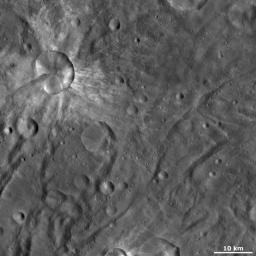This Dawn framing camera (FC) image of Vesta shows Canuleia crater, which is the large, irregularly shaped crater in the top left of the image. Canuleia's average diameter is roughly 11 kilometers (6.8 miles) but it is clear in this image that the diameter running from top to bottom is larger than the diameter running from left to right. Other interesting features of Canuleia include the diffuse bright material that is both inside and outside of its rim and the ridges and gullies around its rim. Also striking is the patch of dark material, with a rounded end, that is located inside and outside of the crater's bottom left quadrant. Surrounding Canuleia are the distinctive curved grooves and ridges of Vesta's southern hemisphere.
This image is located in Vesta's Urbinia quadrangle, in Vesta's southern hemisphere. NASA's Dawn spacecraft obtained this image with its framing camera on Oct. 27, 2011. This image was taken through the camera's clear filter. The distance to the surface of Vesta is 700 kilometers (435 miles) and the image has a resolution of about 65 meters (213 feet) per pixel. This image was acquired during the HAMO (high-altitude mapping orbit) phase of the mission.
The Dawn mission to Vesta and Ceres is managed by NASA's Jet Propulsion Laboratory, a division of the California Institute of Technology in Pasadena, for NASA's Science Mission Directorate, Washington D.C. UCLA is responsible for overall Dawn mission science. The Dawn framing cameras have been developed and built under the leadership of the Max Planck Institute for Solar System Research, Katlenburg-Lindau, Germany, with significant contributions by DLR German Aerospace Center, Institute of Planetary Research, Berlin, and in coordination with the Institute of Computer and Communication Network Engineering, Braunschweig. The Framing Camera project is funded by the Max Planck Society, DLR, and NASA/JPL.
More information about the Dawn mission is online at http://www.nasa.gov/dawn and http://dawn.jpl.nasa.gov.

 Planetary Data System
Planetary Data System












